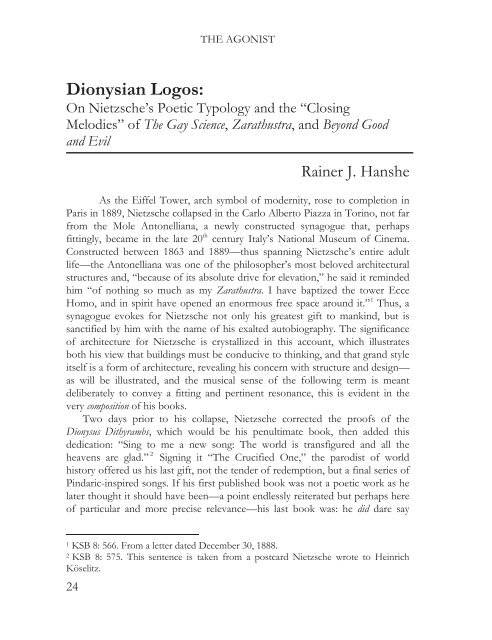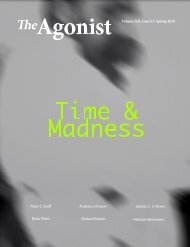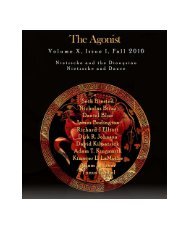Volume XI, Issue II, Spring 2018
You also want an ePaper? Increase the reach of your titles
YUMPU automatically turns print PDFs into web optimized ePapers that Google loves.
THE AGONIST<br />
Dionysian Logos:<br />
On Nietzsche’s Poetic Typology and the “Closing<br />
Melodies” of The Gay Science, Zarathustra, and Beyond Good<br />
and Evil<br />
Rainer J. Hanshe<br />
As the Eiffel Tower, arch symbol of modernity, rose to completion in<br />
Paris in 1889, Nietzsche collapsed in the Carlo Alberto Piazza in Torino, not far<br />
from the Mole Antonelliana, a newly constructed synagogue that, perhaps<br />
fittingly, became in the late 20 th century Italy’s National Museum of Cinema.<br />
Constructed between 1863 and 1889—thus spanning Nietzsche’s entire adult<br />
life—the Antonelliana was one of the philosopher’s most beloved architectural<br />
structures and, “because of its absolute drive for elevation,” he said it reminded<br />
him “of nothing so much as my Zarathustra. I have baptized the tower Ecce<br />
Homo, and in spirit have opened an enormous free space around it.” 1 Thus, a<br />
synagogue evokes for Nietzsche not only his greatest gift to mankind, but is<br />
sanctified by him with the name of his exalted autobiography. The significance<br />
of architecture for Nietzsche is crystallized in this account, which illustrates<br />
both his view that buildings must be conducive to thinking, and that grand style<br />
itself is a form of architecture, revealing his concern with structure and design—<br />
as will be illustrated, and the musical sense of the following term is meant<br />
deliberately to convey a fitting and pertinent resonance, this is evident in the<br />
very composition of his books.<br />
Two days prior to his collapse, Nietzsche corrected the proofs of the<br />
Dionysus Dithyrambs, which would be his penultimate book, then added this<br />
dedication: “Sing to me a new song: The world is transfigured and all the<br />
heavens are glad.” 2 Signing it “The Crucified One,” the parodist of world<br />
history offered us his last gift, not the tender of redemption, but a final series of<br />
Pindaric-inspired songs. If his first published book was not a poetic work as he<br />
later thought it should have been—a point endlessly reiterated but perhaps here<br />
of particular and more precise relevance—his last book was: he did dare say<br />
1 KSB 8: 566. From a letter dated December 30, 1888.<br />
2 KSB 8: 575. This sentence is taken from a postcard Nietzsche wrote to Heinrich<br />
Köselitz.<br />
24









